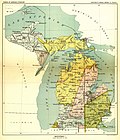
The United States was the first jurisdiction to acknowledge the common law doctrine of aboriginal title (also known as "original Indian title" or "Indian right of occupancy"). Native American tribes and nations establish aboriginal title by actual, continuous, and exclusive use and occupancy for a "long time." Individuals may also establish aboriginal title, if their ancestors held title as individuals. Unlike other jurisdictions, the content of aboriginal title is not limited to historical or traditional land uses. Aboriginal title may not be alienated, except to the federal government or with the approval of Congress. Aboriginal title is distinct from the lands Native Americans own in fee simple and occupy under federal trust.
Contents
- History
- Before 1776
- 1776–1789
- Since 1789
- Sources of law
- Federal
- Doctrine
- Acknowledgement
- Content
- Extinguishment
- By geography
- East of Mississippi
- Louisiana Purchase and Texas
- Hawaii
- Mexican Cession
- Oregon territory
- Alaska
- Other
- Possessory cause of action
- Compensatory causes of action
- Constitutional
- Statutory
- Affirmative defenses
- Immunity
- Delay
- Relationship to other rights
- See also
- Notes
- References
- Further reading
The power of Congress to extinguish aboriginal title—by "purchase or conquest," or with a clear statement—is plenary and exclusive. Such extinguishment is not compensable under the Fifth Amendment, although various statutes provide for compensation. Unextinguished aboriginal title provides a federal common law cause of action for ejectment or trespass, for which there is federal subject-matter jurisdiction. Many potentially meritorious tribal lawsuits have been settled by Congressional legislation providing for the extinguishment of aboriginal title as well as monetary compensation or the approval of gaming and gambling enterprises.
Large-scale compensatory litigation first arose in the 1940s, and possessory litigation in the 1970s. Federal sovereign immunity bars possessory claims against the federal government, although compensatory claims are possible by statute. The Eleventh Amendment bars both possessory and compensatory claims against states, unless the federal government intervenes. The US Supreme Court rejected nearly all legal and equitable affirmative defenses in 1985. However, the Second Circuit—where most remaining possessory claims are[ when? ] pending—has held that laches bars all claims that are "disruptive."











